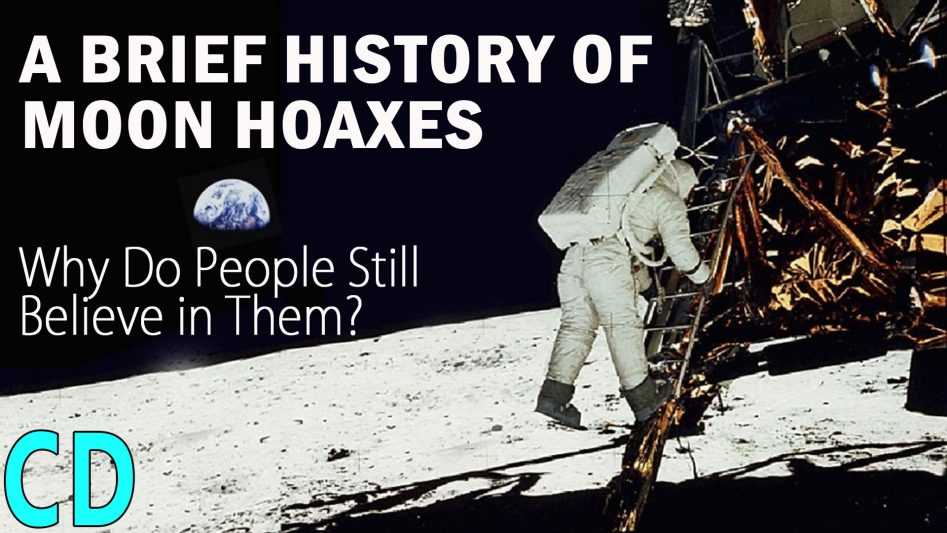How did we get from one of the greatest technological achievements of the 20th century to believing that it was a massive cover up by NASA, the CIA, the government or a combination of all three?, and why almost 50 years after the first Apollo missions, with all the scientific proof available, do an increasing number of people believe in an a radically different version of reality?.
Conspiracy theories about the Apollo missions have been circulating since before the moon landings.
One of the first reported instances of people not believing that the moon landings were true came on December 18th, 1969, 5 months after first moon walk, when the New York Times science reporter , John Noble Wilford in an article called “A Moon Landing? What moon landing?” remarked that ― “A few stool warmers in Chicago bars are on record as suggesting that the Apollo 11 moon walk last July was actually staged by Hollywood on a Nevada desert.”
Six months later, on June 15th 1970, the Atlanta Constitution led with the story “Many sceptics feel moon explorer Neil Armstrong took his ‘giant step for mankind‘ somewhere in Arizona”. The article was based on a poll of 1,721 U.S. citizens that were asked “Do you really, completely believe that the United States has actually landed men on the moon and returned them to earth again?”
The poll results showed that less than 5% of responders in Detroit, Miami, and Akron believed they were fake but that increased to 54% of African Americans in places such as Washington DC.
An early common theme was that because of the cold war between the US and the Soviets, the US could not be seen to lose the race to the moon but when they realized that it couldn’t be done, NASA faked the missions and used the funds to buy the silence of potential whistle blowers.
Other ones said that we could never get to the moon because the astronauts would have been killed by the radiation in the Van Allen Belts which surround the earth. This is down a poor understanding of the science of radiation and that all radiation is not the same. As we will see, It’s this “bad science” that is the underpinning of most the moon hoax theories”
One theory by William Brian said that we did go to the moon but only with the help of Alien technology and NASA couldn’t risk the public finding out about this as they would have disclose how they got.
Another by Richard Hoagland says that NASA had discovered large artificial glass structures on the lunar surface and that the astronauts had their memory of any alien encounters erased by hypnosis. He also said that the moon landing hoaxes had been created by NASA themselves to act as disinformation to put people off the bigger picture of the aliens.
You may well recognize a similarity to the plot of the 1968 Stanley Kubrick film “2001, A space odyssey” which in turn was based on a 1964 short story by Arthur C. Clarke called “The Sentinel”. This was well before the moon landings and any of the subsequent moon conspiracy theories, so you can see where these ideas can come from.
Over time these same early themes have been recycled again and again with changes here and there. One thing that does remain the same is that they are all different, if NASA had concocted a hoax there could be only one version it.
It wasn’t until 1975 that the first so called “evidence” based denials appeared by Bill Kaysing, a journalist who had worked for Rocketdyne Inc, the makers of the F-1 rocket engines that powered the Saturn Five moon rockets.
His 1975 self published booklet tilted “We Never Went to the Moon: America ‘s Thirty Billion Dollar Swindle!” which was republished in 1981 and 2002, is acknowledged as the first to layout many of the arguments which have been taken up by subsequent conspiracy theorists.
It’s here that we see the “bad science” at work as he puts forward the missing stars in photos of the astronauts, the flag waving when there is no air, lack of a blast crater under the lunar lander from its descent and optical anomalies in photos taken on the moon.
He also puts forward the assumption that NASA did not have the technical expertise to operate the moon landings and that the F-1 rocket engines were so unreliable, that the ones on the Apollo 11 rocket were fake, with smaller B-1 type engines inside them. This later point has been proved incorrect by the recovery of the actual F-1 engines used on Apollo 11 from the Atlantic ocean by Jeff Bezos, the owner of Amazon.
Kaysing who was neither a scientist or engineer, worked as the head of the technical publications and as a publications analyst at Rocketdyne until May 31st 1963, 6 years before the moon landings. He said he came to these and later conclusions because he had been seen documents relating to Mercury, Gemini, Atlas and Apollo and that you didn’t to be a trained professional to know a hoax was being perpetrated.
Kaysing’s theories subsequently become even more extreme when he alleged that NASA staged the Apollo 1 fire and the Space Shuttle Challenger disaster because the astronauts were about to reveal the hoax and had to silence them in a convincing manner.
Hollywood also helped to popularize the moon hoax’s with films like the 1978 “Capricorn One” which deals with NASA faking a Mars mission due to technical problems discovered just before the launch that would have killed the astronauts if they continued and ensuing cover up.
In 2001 the conspiracy theorists received a huge boost with the FOX TV documentary “Conspiracy Theory: Did We Land on the Moon?”. The program aired on mainstream TV and Bill Kaysing was one of the main contributors.
Because this came out over 30 years after the moon landings, it reintroduced the Conspiracy Theories to a new audience, many of which without a technical understanding would have found it compelling in its arguments. But program didn’t offer a reply to the allegations which included that astronauts and others had died in mysterious circumstances to hide the so called truth.
This is where the US government and NASA have also been their own worst enemy in creating an atmosphere of distrust and enabling the conspiracies to develop.
Things like the Watergate debacle, the Iran contra affair and the refusal of NASA to talk about the allegations because they thought they were too absurd to warrant a reply, just helped the conspiracy theorist’s arguments.
An opinion poll conducted in 1964, marked a high point in the publics belief in the government with 76% of people saying that they believed that the US government would do “what is right” most or all of the time, by the early 1990’s that figure had fallen to less than 25%.
It’s one thing to create conspiracies but you still need people to believe in them. This is where the emphasis moves from the hoax creators to the believers and evangelizers that embrace and repeat conspiracy theories, often with little regard to the poor and incorrect understanding of the science that these theories are based on.
Belief is the major component here. There is a basic tenant in physiology, in that once someone firmly believes in something, whether that be conspiracy theories, politics, religious beliefs, aliens, ghosts or whatever, no matter what proof is forwarded to the contrary, it can almost impossible for them to change their minds because they want to believe in them and for some to the point of fanatical hostility when repeatedly challenged.
In fact, there is a phenomenon known as the “backfire effect”, where the more aggressively someone asserts a particular point of view with scientific proof like NASA, the more it pushes the conspiracy believers in the opposite direction and reinforcing their convictions.
So why are some people drawn to alternate viewpoints and others not. This tendency cuts across age, racer, gender, occupation and political standing. One area which does show a difference is education.
Research carried out by the University of Miami using long-term empirical data found people with a high school education were almost twice as likely at 42%, to believe in conspiracy theories of all types compared to ones with post graduate degrees at 23%.
A recent poll carried out by Fairleigh Dickinson University showed that 63% of registered US voters believed in at least one political conspiracy theory. According to professor of psychology, Viren Swami of Westminster University, England, once you believe in one conspiracy theory, you are much more likely to believe in others.
Psychological testing has revealed that people are more susceptible to conspiracy theories if they feel anxious, under stress or feel they don’t have control over their lives. This is believed to trigger some people to see non-existent patterns and attributing conspiratorial explanations.
Compared to the 60’s, 70’s and even 80’s, the world now is a very different place. The so called surveillance society with it privacy issues, leaks about eves dropping on web browsing and emails, job uncertainty, poverty, terror attacks, a highly unequal society and living in a rapidly changing and unpredictable world, all contribute to the feeling of lack of control for great deal more people that it did in the past.
The internet has made the things worse with a world of information both good and bad just a Google search away. The problem here is of “confirmation bias”. This is the tendency to only believe the evidence that supports your point of view and the tribalism of people that occurs on chat rooms, blogs, forums and Youtube channels also helps reinforce false information and the us and them view of the world.
Whilst believing that you know that NASA faked the moon landings might make you feel in control, it does not actually give you any control.
The problem with this lack of faith in the scientific endeavour is where will it take you in the future, to some it seems no matter what NASA or others might do there will all ways be some hidden agenda and this negates from the achievements that Apollo did 50 years ago and those still yet to come.



